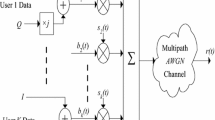Abstract
To improve the performances of the wireless mobile communication system, a statistical method is illustrated in this paper. It consists in separating the signals at the reception of communication systems based on code division multiple access technology. The idea is to optimize the separation of the various users sharing the same frequency and temporal resources using the emergent statistical method of independent component analysis (ICA). ICA makes it possible to extract emitted signals that are as statistically independent as possible. The bit error rate and the signal to noise ratio are used as criteria for evaluating the performances of the ICA receiver. Adding white Gaussian noise to the input signal channel and the Rayleigh channel (fading channel) cases has been considered. A comparative study with conventional receivers such as the RAKE, the matched filter (MF), and the minimum mean-squared error is carried out. The obtained results show the superiority of an ICA receiver compared to an MF receiver.
Similar content being viewed by others
References
Lee, T.W., Girolami, M., and Sejnowski, T.J., Independent Component Analysis Using an Extended Info-max Algorithm for Mixed Sub-Gaussian and Super Gaussian Sources, Neural Computation, 1999, vol. 2, pp. 417–441.
Moshavi, S., Multi-user Detection for DS-CDMA Communications, IEEE Communications Magazine, 1996, vol. 34, no. 10, pp. 124–136.
Cristescu, R., Ristaniemi, T., Joutsensalo, J., and Karhunen, J., Blind Separation of Convolved Mixtures for CDMA Systems, in Proc. Eur. Signal Processing Conf. (EUSIPCO’OO), Tampere, Finland, 2000, pp. 619–622.
Waheed, K., Desai, K., and Salem, F.M., Blind Multi-user Detection in DS-CDMA Systems Using Natural Gradient Based Symbol Recovery Structures, in Proc. 4th Int. Conf. Independent Component Analysis and Blind Signal Separation, Japan, 2003, pp. 727–732.
Dahmane, A.O., A New MMSE based Cascade Filter MUD Tracking Mode in Time-Varying Channels, IEEE WiMob Conference, Montreal, Canada, 2005, pp. 314–318.
Ristaniemi, T. and Joutsensalo, J., Advanced ICA-based Receivers for DS-CDMA Systems, in Proc. IEEE PIMRC, London, 2000, pp. 520–524.
Raju, K. and Ristaniemi, T., ICA-RAKE Switching for Jammer Cancellation in DS-CDMA Array Systems, in Proc. IEEE Int. Symp. on Spread Spectrum Techniques and Applications (ISSSTA’02), Prague, Czech Republic, 2002, pp. 638–642.
Lupas, R. and Verdu, S., Linear Multi-user Detector for Synchronous Code Division Multiple Access Channels, IEEE Transactions on Information Theory, 35, 1989, pp. 3812–3816.
Ristaniemi, T., Raju, K., Karhunen, J., and Oja, E., Jammer Cancellation in DS-CDMA Arrays: Pre and Post Switching of ICA and RAKE, in Proc. of the 2002 IEEE Workshop on Neural Networks for Signal Processing, Martigny, Switzerland, 2002, pp. 495–504.
Durán, J. and Cruces, S., An Application of ICA to Blind DS-CDMA Detection: A Joint Optimization Criterion, 7th International Work-Conference on Artificial and Natural Neural Networks (IWANN’2003), Spain, 2003, vol. 2, pp. 305–312.
Tugnait, J.K. and Li, T., Blind Detection of Asynchronous CDMA Signals in Multipath Channels Using Code-Constrained Inverse Filter Criterion, IEEE Trans. Signal Processing, 2001, vol. 49, no. 7, pp. 1300–1309.
Cardoso, J.F., Blind Signal Separation: Statistical Principles, Proc. the IEEE, 1998, vol. 86, no. 10, pp. 2019–2025.
Gupta, M. and Santhanam, B., ICA Based Blind Adaptive MAI Suppression in DS-CDMA Systems, Proc. of IEEE-DSP Workshop—Taos Ski Valley, 2004, pp. 201–205.
Ekici, O. and Yongacoglu, A., Application of Noisy Independent Component Analysis for CDMA Signal Separation, in Proc. of IEEE-DSP Workshop, Taos SkiValley, 2004, pp. 3812–3816.
Lupas, R. and Verdu, S., Linear Multi-user Detector for Synchronous Code Division Multiple Access Channels, IEEE Transactions on Information Theory, 1989, pp. 3812–3816.
Lee, T.W., Girolami, M., Bell, A.J., and Sejnowski, T.J., A Unifying Information-Theoretic Framework for Independent Component Analysis, Neural Networks, 2000, vol. 39, pp. 1–21.
Hyvdrinen, A., Fast and Robust Fixed-Point Algorithms for Independent Component Analysis, IEEE Transactions on Neural Networks, 1999, vol. 10, no. 3, pp. 626–634.
Author information
Authors and Affiliations
Corresponding author
Additional information
Original Russian Text © A. Hamza, S. Chitroub, 2007, published in Avtomatika i Vychislitel’naya Tekhnika, 2007, No. 6, pp. 63–71.
The text was submitted by the authors in English.
About this article
Cite this article
Hamza, A., Chitroub, S. Performance study of receiver based on independent component analysis in CDMA systems. Aut. Conrol Comp. Sci. 41, 343–349 (2007). https://doi.org/10.3103/S0146411607060077
Received:
Issue Date:
DOI: https://doi.org/10.3103/S0146411607060077




